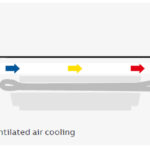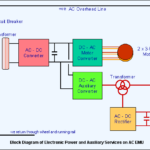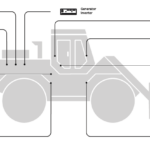Renesas Electronics Corporation introduced a family of motor driver ICs for brushless DC (BLDC) motor applications. The devices implement Renesas’ new, patent-pending technologies that enable full torque at zero speed from motors without sensors, an industry first. The new motor driver ICs enable Renesas customers to design sensorless BLDC motor systems with higher horsepower and […]
Motors and motor control
FAQ on traction motors, part 3
Traction motors are optimized for locomotives, EVs, elevators, and other situations where high torque at start-up and low speed is needed. The final part of this article examines additional traction-motor issues. Q: What about physical size and associated issues in traction-motor applications? A: Inner-city urban light-rail vehicle (LRV) floors are typically low since the stops […]
FAQ on traction motors, part 2
Traction motors are optimized for locomotives, EVs, elevators, and other situations where high torque at start-up and low speed is needed. The previous part of this article established the context for traction motors. This part looks at traction motors in more detail. Q: What is the relative position of DC versus AC traction motors? A: […]
FAQ on traction motors, part 1
Traction motors are optimized for locomotives, EVs, elevators, and other situations where high torque at start-up and low speed is needed. Motors are an essential part of many system designs, yet their diverse variations are a mystery to many electrical engineers and a surprising number of mechanical engineers. There are several reasons for general confusion […]
How to commutate BLDC motors
BLDC motors are highly efficient and growing in use in various applications such as robotics, electric vehicles, and drones. However, to extract optimal performance from these motors, the correct commutation technique is crucial. Commutation is the process of changing the direction of the current in the motor windings, which generates torque and rotates the motor. […]
Silicon carbide MOSFET operates to 1200 V, 37 A
Diodes Incorporated introduces the latest addition to its portfolio of Silicon Carbide (SiC) products: the DMWS120H100SM4 N-channel SiC MOSFET. This device addresses the demand for higher efficiency and higher power density for applications such as industrial motor drives, solar inverters, data center and telecom power supplies, DC-DC converters, and electric vehicle (EV) battery chargers. The […]
MOSFETS target EV motor, battery management apps
Magnachip Semiconductor Corporation announced that the company had launched its eighth-generation 150V MXT Metal-Oxide-Semiconductor Field-Effect Transistor (MOSFET)1 optimized for Light Electric Vehicle (LEV) motor controllers and battery management systems (BMSs). Energy efficiency plays a critical role in electric devices regarding power consumption and product stability. This newly-released MOSFET (MDT15N054PTRH) features Magnachip’s eighth-generation trench MOSFET technology […]
GaN FETs feature low on resistance with 150/200-V ratings
EPC introduces the 150 V, 3 mΩ EPC2305 and the 200 V, 5 mΩ EPC2304 GaN FETs in a thermally enhanced QFN package with an exposed top and tiny 3 mm x 5 mm footprint. These devices are the lowest on-resistance (RDS(on)) FETs in the market at 150 V and 200 V in a size that […]
eGaN power FETs feature high power density, tiny footprint
EPC launches the 80 V, 4 mOhm EPC2619. This is the lead product for a new generation of eGaN devices that have double the power density compared to EPC’s prior-generation products. The EPC2619 has an RDS(on) of just 4 mOhms in a tiny, 1.5 mm x 2.5 mm, footprint. The maximum RDS(on) x Area of […]
SiC MOSFETs target automotive, industrial uses
Alpha and Omega Semiconductor Limited announced its new industry-leading 650V and 750V SiC MOSFET platform for both industrial and automotive applications. The 650V SiC MOSFETs are ideal switching solutions for industrial applications such as solar inverters, motor drives, industrial power supplies, and new energy storage systems, while the AEC-Q101 qualified 750V SiC MOSFET line is targeted […]











